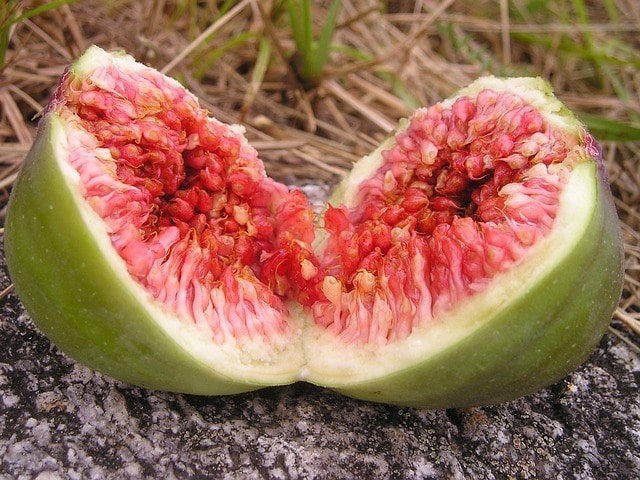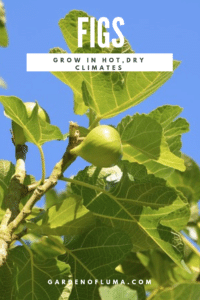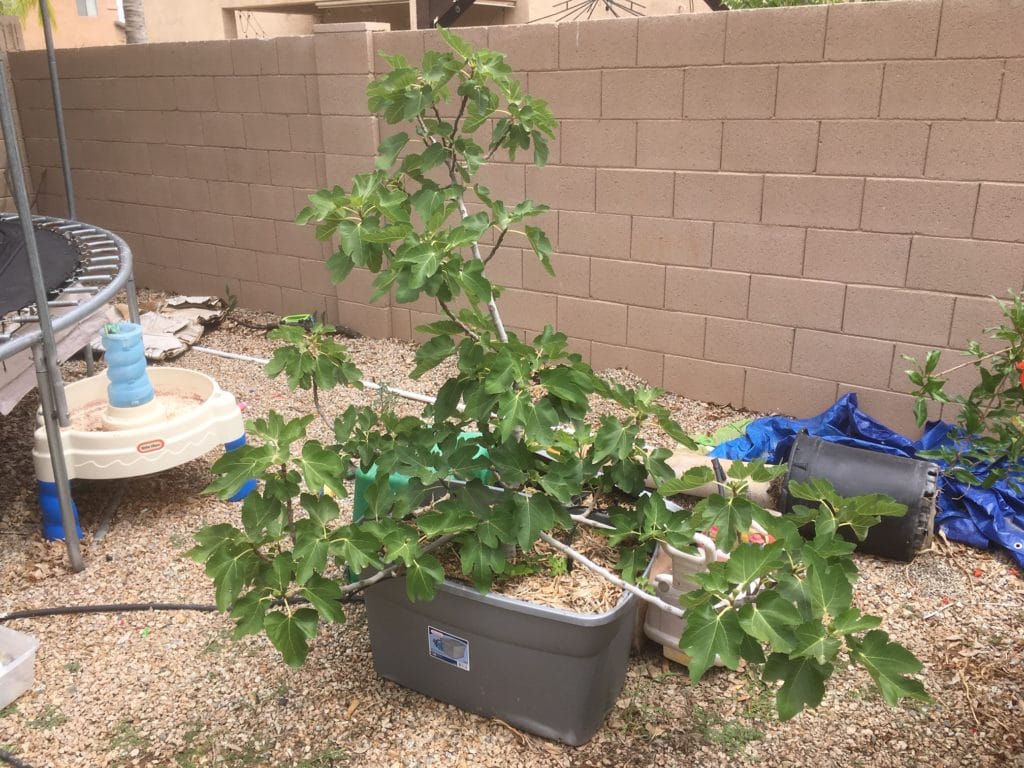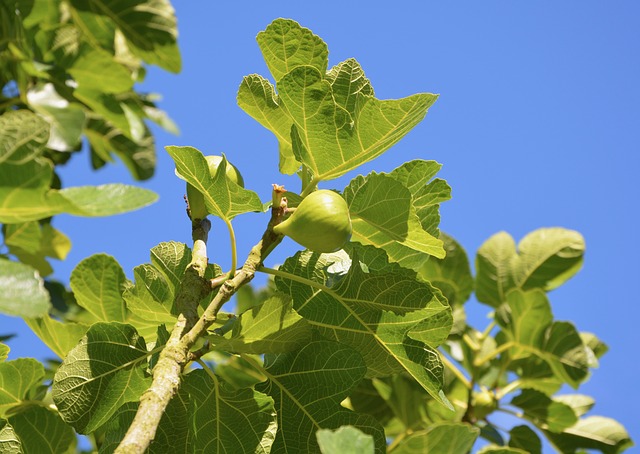Growing Fig Trees in Hot, Dry Climates

One of the best plant purchases I ever made was a Black Mission starter tree for $2.50. It didn’t look like much, just a 6-inch twig with a couple leaves, but it took off that first summer. Fig trees are one of the easiest fruit trees to grow in hot climates.
A fresh fig is a delectable treat to enjoy. Fig trees are majestic trees that have beautiful large leaves and have stood the test of time. In my yard, I have three fig varieties a Black Mission, Violette De Bordeaux, and Peter’s Honey.
Black Mission Figs are one of those staple varieties that have been proven to do well in hot climates. Like its name suggests, it’s a black skinned variety with a red flesh. This is one of my favorite figs and the tree tends to be very productive.
Violette De Bordeaux has a similar look and flavor as the Black Mission, but the tree tends to be smaller and is a great variety for containers. Peter’s Honey is a white fleshed that has a sweet honey flavor as the name suggests. All of my fig trees are grown in containers.
CLICK THIS LINK TO PURCHASE YOUR OWN BLACK MISSION FIG TREE
Fruiting

Fig trees tend to be self-pollinating and don’t require a second tree for cross pollination. There are hundreds of varieties of figs, but many tend to have either a whitish or reddish flesh. The white fleshed varieties usually have a slightly yellow skin color when ripe, while the red fleshed have a dark brown or black skin when ripe.
I tend to prefer the red flesh varieties which tend to have some berry undertones. The whiter flesh varieties are typically more honey like. They’re both tasty. Many Fig varieties produce multiple crops in a year. Some varieties produce a breba crop, which is an early crop produced on last year’s growth.
The main crop tends to be the heavier producing yield and better tasting. In cooler climates, it may not be warm enough for the main crop to fully ripen, so they have to rely on the breba crop.
Propagating
Figs are very simple to propagate from cuttings. With their aggressive roots it makes it easy to get them going. All three of my fig trees were started from cuttings which is a common method for propagating fig trees. You can find my method for rooting fig trees on my post: Root Fruit Tree Cuttings in 5 Easy Steps.
There are many places to find more exotic fig cuttings for purchase that can be grafted to existing trees or rooted. They tend to take readily when grafted so you can grow one large tree and graft on several varieties to create a fig cocktail tree.

Gardening Skill Level
I would say that growing Figs in a hot, dry climate is definitely for the beginning gardener. Fig trees are one of the easiest fruit trees to grow in a hot climate. Figs can handle our mild winters with no issues, so frost protection is never needed.
Figs aren’t very particular about pruning, fertilizing, or soil requirements. Brown Turkey, Kadota, and Black Mission are common varieties in our desert climate, but many additional varieties are well adapted to our hot weather.
Suitable for Container Growing

Figs do very well in containers when properly cared for. This is my method for growing all my fig trees. They will need to be root pruned every year or two to be maintained in a container. The roots fill up a container fairly quickly.
Gradually move the tree up to the next larger size pot as the tree grows. Some varieties are naturally dwarf and are better suited for containers like Little Ruby or Violette De Bordeaux. If you’re diligent with pruning you can virtually grow any fig in a container. I’m growing a Black Mission which is known to be an aggressive, fast growing fig variety in a container.
If utilizing black pots in hot climates, make sure you’re doing something to shade the container. Black pots can absorb the sunrays and heat up the roots quickly. Check out my complete guide to growing fruit trees in containers in hot climates for more insight.
Planting Tips
Fig trees aren’t very picky when it comes to planting. Well-draining soil works best. Fig trees can handle full sun, even in our desert summers. They’re a heat loving plant and need an adequate amount of sun for fruit ripening. Fig trees seem to tolerate our clay soil fairly well.
Watering
Fig trees are very good about telling you if they’re thirsty. You’ll notice the large leaves start to droop when they need water. You may also see some yellowing on older leaves during drought stress. See my post: 7 Reasons Why your Fruit Trees are Losing Leaves.
Young trees will need more frequent irrigation a few times a week during the hot months, otherwise established trees can be watered deeply once a week or so in the summer.
Feeding
Fig trees are not fussy with fertilizing needs. A good balanced fertilizer can be applied once or twice a year. Fig trees grown in ground can even go without much fertilizer at all if mulched and topped periodically with compost. Container fig trees will benefit more from a consistent feeding schedule.
I feed my fig trees implementing the same regimen as most of my tropical fruit trees. I give them a regular dose of liquid fish emulsion and seaweed fertilizer throughout the growing season. I also periodically top with compost. Here are my recommended garden products.
Sun Exposure

Fig trees like full sun. It’s important to plant fig trees in an area where they’re going to get a lot of sun. You don’t want to plant fig trees in a shady spot. Many fig varieties can get quite large and end up being shade trees for other plants. There is no need for shade cloth, even in our desert summers.
Potential Problems
Fig trees are virtually pest and problem free trees. I haven’t noticed many diseases or problems with figs. One thing to consider is planting varieties with closed eyes. Some fig varieties produce figs that have a small opening on the end of the fig. These types of open-eyed figs are more susceptible to ants and bugs getting into the fruit.
One concern to note is that Fig trees can have aggressive root systems. It isn’t recommended to plant vigorous varieties near your house foundation, walls, or structures. More insight can be found at my post: Smart Strategies for Fruit Trees with Invasive Roots. Birds can be a nuisance as it seems they love figs just as much as we do.
They tend to peck at those plump figs just before you’re about to enjoy it. Bird netting or organza bags can help to protect your fruit. Otherwise figs are really a great tree for beginning gardeners.
Please comment below on anything that you’ve enjoyed from this post or your experience growing fig trees in hot climates.
